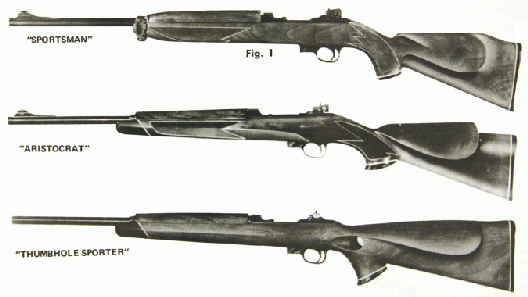Post WWII Commercially Manufactured M1 Carbines
 |  Williams Gun Sight Company |
|
|
 |  Williams Gun Sight Company |
|
|
|
Introduction
Williams Gun Sight Company has manufactured after market gun sights and accessories since 1926.
The company was founded by Harvey Williams and has been run by him, his six sons, and their families. The factory, gunsmithing services, an onsite sporting goods store,
rifle range, pistol range, and trap & skeet range are all located at their facility in Davison, Michigan.
The gun sights they've been best known for are their rear peep sights for rifles, which are popular for competitive shooting.
 Williams Gun Sight Company 1965 |
Background
The early to mid 1960's experienced a tremendous growth in military surplus firearms. Between 1962 and 1965, surplus GI carbines became available in the tens of
thousands from importers and the Director of Civilian Marksmanship through the NRA. There were at least five different commercial manufacturers producing civilian
versions of the M1 carbine. Williams Gun Sight designed a number of after market add-ons to customize these rifles as sporters for hunting.
Williams Gun Sight published their Shooters Catalog of the products they manufactured and carried, every two years. The catalogs were numbered versus dated, with the 11th Edition published for 1963 and the 12th Edition published for 1965. The popularity of sporterizing military rifles for hunting led Williams Gun Sight to also publish a catalog entitled How to Convert Military Rifles, with the 4th Edition published for 1964, the 5th Edition for 1966, and the 6th Edition for 1968. The focus of this latter publication was sporterizing surplus military weapons using the products manufactured and sold by Williams Gun Sight. The company also offered the services of their in-house gunsmiths for any and all parts of the conversions.
 Williams Shooters Catalog 12th Edition, 1965 |  Williams How To Convert Military Rifles 5th Edition, 1966 |  Williams How To Convert Military Rifles 6th Edition, 1968 |
Gunsmith services also included the option of custom rebluing of the rifles.
Williams Gun Sight's Custom "One of Fifty" Sporterized Collector M1 Carbines
The 1967 Twenty-First Edition of the annual Gun Digest includes an article entitled "Why Won't the GI Carbine Die, Nobody Likes this Little Rifle but People..." [pp.237-242]. The author stated "...exactly 50 One of Fifty William's sporters at somewhat over $250 unscoped [note: new commercial carbines cost about $69-$79 at the time, surplus GI M1 carbines about $59]. I asked the Williamses about these, and Boyd said they put an all-out carbine on the cover of Catalog #12, and enough interest was aroused to try a special promotional program. The demand runs 10-1 over the supply ...".
The 1966 5th Edition of How to Convert Military Rifles features a One of Fifty on the cover, with a close up of the inscription engraved on the barrel band indicating the first of fifty, and 1966.

|
On page 10: "The Williams Gun sight Company produced 50 of the sporterized M1 Carbines that are on the cover of their #12 Shooter's Catalog. On the barrel of each is engraved "One of Fifty", followed by the registered sequence number. Only fifty of the M1 carbines so equipped and engraved will ever be made."
"This Williams sporterized M1 Carbine features a thumbhole-pistol-grip Mannlicher stock that is tastefully checkered and hand finished. Metal is completely refinished and blued. The magazine is shortened to a five shot. Receiver sight is the new WGRS-M1-CAR with precise windage and elevation adjustments and positive locks. The front sight is a .312 Ivory bead on a 9/32" Shorty ramp. Swivels and the attractive carved leather, guide carrying strap complete the unique sporterizing of these collector pieces."

Lynn Anderson was kind enough to share his carbine for the photographs that follow,
as an example of the
Williams Gun Sight Custom One of Fifty Sporterized Collector M1 Carbines.



The stock and handguard used for the One of Fifty series was a hand made custom version of the Reinhart Fajen "Thumbhole Sporter" model. Reinhart Fajen was a stockmaker in Warsaw, Missouri. His custom stockmaking/fitting company was world renowned for quality. The company was founded in September 1957, and by 1966 manufactured custom stocks for almost any rifle. In 1986 the company merged with another Warsaw, MO custom stock maker, E.C. Bishop and Son. The Thumbhole Sporter Mannlicher stock hand made by Reinhart Fajen for Williams Gun Sight was absolutely stunning.

The trade names "Fajen" and "E.C. Bishop" were acquired by Larry Potterfield, owner of Midway USA. Potterfield has purchased a number of additional well known firearms accessories companies that he operates under a parent company, Battenfeld Technologies of Columbia, MO. The stocks Battenfield Technologies sells under the names of Fajen and E.C. Bishop do not share the degree of craftsmanship as those produced by the two original master stock makers.
One of Fajen's partners founded Wenig Custom Gunstocks of Lincoln, Nebraska. This company is the equivalent of the quality of craftsmanship of Fajen and E.C. Bishop. Wenig stocks are hand crafted to fit the customers rifle.




|
|